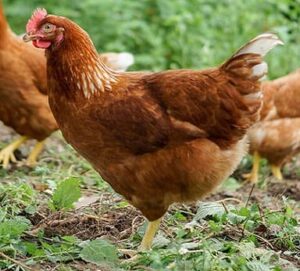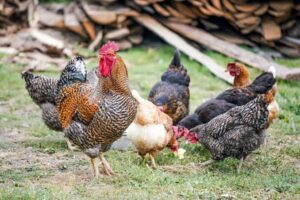ROLE OF BACKYARD POULTRY IN RURAL DEVELOPMENT
Arul Sabareeswaran T A1, Alimudeen S1, Abrar Basha MHS2 and Hariharan R3
- V.Sc Scholar, College of Veterinary and Animal Sciences, Pookode, Kerala Veterinary and Animal Sciences University, Wayanad-673576
- V.Sc Scholar, College of Veterinary and Animal Sciences, Mannuthy, Kerala Veterinary and Animal Sciences University, Wayanad-673576
- PhD Scholar, College of Veterinary and Animal Sciences, Pookode, Kerala Veterinary and Animal Sciences University, Wayanad-673576
INTRODUCTION
India is an agricultural country and 67 percent of the people live in rural areas according to the census 2011. It is said that most rural youths face unemployment and are suffering for their livelihood and have low living standards. Now Backyard poultry is emerging as a source of income generation and also provides protein in the form of meat and egg consumption to rural people.
Globally, the majority of poultry meat and egg comes from intensive rearing methods, which are based on the high cost of investments and instruments for production. This type of intensive type of rearing is more common in urban and semi-urban areas all around the country. For the past 3 decades, the poultry industry in India has seen a massive jump in poultry production. While this intensive type of rearing is not so popular among rural areas due to the lack of capital investment and less demand for processed and stored chicken meat.
BACKYARD POULTRY PRODUCTION
Backyard poultry is an age-old traditional practice where small numbers of native chickens are reared with or without inputs under free-range scavenging conditions. Poultry is one of the oldest domesticated species in the history of mankind, more specifically in the Indus valley civilization which later on spread all around the world. Small-scale poultry production in been a part of social and cultural development over many years in both developing and developed countries.
This backyard poultry production is been followed for so many years in the villages of India, so modern backyard poultry production was introduced several decades ago with a motive to develop high-performing birds suitable for backyard rearing across all the agroclimatic zones of India. The University of Agricultural Sciences, Bangalore pioneer in the development of backyard poultry breeds in India. Finally, ICAR developed a dual-purpose breed Vanaraja in the year of 1999 and Gramapriya a brown egg-laying breed was developed in 2015. The success of these two breeds leads to the formation of many other breeds and the adoption of this backyard rearing in rural areas. The backyard poultry breeds have special attributes in both qualitative traits like the colour of plumages and meat quality and quantitative traits like body weight and relatively high immune system compared to other poultry breeds.
 |
 |
| VANARAJA | GRAMAPRIYA |
INDIAN STATUS
Backyard poultry contributes about 17.8 per cent (18.41 billion) of India’s total egg production (103.32 billion). Of the total egg production from the BYPF, the native fowls produce about 11.9 billion eggs, the improved fowls lay about 5.19 billion eggs, while other avian species produce 1.32 billion eggs in the country. India ranks 3rd in egg production and 5th in meat production in the world and the per capita availability is 79 eggs and 3.12 kg of chicken meat per annum.
Rapid urbanization and economic growth have resulted in the fast expansion of commercial poultry production units. As a result, market-oriented backyard poultry enterprise is being recognized as a stepping stone for poor households enabling them to take the first step towards breaking out of the vicious circle of poverty and deprivation.
CHARACTERISTICS OF BACKYARD POULTRY
Backyard poultry is low input activity primarily depending on scavenging on the natural feed base with little supplementary feeding, night shelter and minimum health care practices. The birds scavenge for feed, consume household waste and insects, and utilize resources that are not directly useful to humans or livestock. Backyard poultry production is comprised of two phases of rearing, i.e., nursery and free-range rearing for the sustenance of the activity.
Nursery Rearing
Rearing newborn chicks by artificially providing all the requirements (warmth, feed, protection from predators, etc.) that are provided by the mother to young chicks is called nursery rearing.
Free-Range Rearing
The chicks are introduced into the farmer’s backyards at 4–6 weeks of age depending on the environmental temperature. The number of chicks per household depends on the area and the natural food base available. However, a unit with 15 to 20 birds per household is ideal for the successful and effective management of birds. Supplementary feeding is essential in this system for realizing optimum productivity from the birds. The birds are let out for foraging during the daytime and kept in night shelters or houses during the night.
Backyard poultry is advantageous as it provides supplementary income in the shortest possible time with minimum capital investment, is simple in operation and ensures the availability of eggs and meat even in remote rural areas. The indigenous birds used are better adapted to scavenging systems characterized by continuous exposure to disease incidence, inadequate quantity and quality of feed, poor housing and health care
BACKYARD POULTRY LINKED WITH RURAL DEVELOPMENT
Backyard poultry is a potent tool for the upliftment of the poor because it requires hardly any infrastructure setup. Besides off-farm employment and income generation, rural backyard poultry can provide nutrition in the form of valuable animal protein as well as a source for religious sacrifices. More than 90 per cent of rural families keep one or more species of poultry birds. Backyard poultry production has a proven potential to alleviate poverty, eradicate malnutrition, generate subsidiary income, empower women and provide gainful employment in rural and tribal areas of the country.
Backyard poultry production is considered an integral part of many families and an income-generating activity in developing countries for women. Women manage most of the activities of backyard poultry production like feeding, watering, cleaning and selling chickens and eggs and 95 per cent of the village poultry flocks are owned and managed by women. In recent years there is been recognized development in the community concerning backyard poultry production. There is also growing evidence to demonstrate the role of backyard poultry production in enhancing the food and nutrition security of poor households and also in the promotion of gender equality. Rural poultry has a remarkable contribution to the development of rural families and the overall development of the poultry sector. Almost 90 per cent of all rural families keep a small number of native chickens and ducks under traditional free-range semi-scavenging systems.
Backyard poultry production forms the basis for transforming the rural poultry sector from subsistence to a more economically productive base. Increasing meat and egg production from backyard poultry has been a major concern for the Government of India for many years and thus government supports various programs to improve backyard poultry production. The state and central governments provide financial support to a certain extent and encourage women, self-help groups, entrepreneurs, government and non-government agencies, to set up mother units to take care of chicks in the first four weeks of life before they can be distributed for rearing. According to the Indian government’s National Action Plan for Egg and Poultry-2022 (NAPEP), a component under National Livestock Mission (NLM), namely, Rural Backyard Poultry Development (RBPD) covers beneficiaries from Below Poverty Line (BPL) families to enable them to gain supplementary income and nutritional support.
CONCLUSION
The backyard poultry farming is a promising sector for the nutritional security and upliftment of livelihood of rural landless poor/ deprived farmers of India. It also helps in employment generation and women empowerment. Recent advances in this field like improved variety of breeds especially suitable for backyard poultry production, availability of inputs, ever increasing demand for desi products are the reasons why backyard poultry is in growing trend. Government should provide constant support to find organizational solutions to minimize public-health risks and provide appropriate extension support on issues like disease prevention, predation and improving hatchability to the producers. The premium price and huge demand for the free-range eggs and meat is another asset of backyard poultry production, which is going to increase further in the future.


